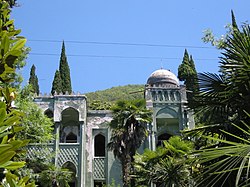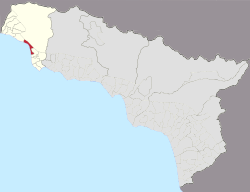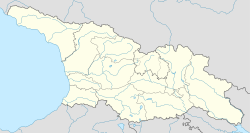Gagry
|
Gagra გაგრა (in Georgian) Гагра (in Abkhaz) |
||
|---|---|---|
| Town | ||

Old Gagra
|
||
|
||
 Location of Gagra in Abkhazia(Geogria საქართველო) |
||
| Location of Gagra in Georgia | ||
| Coordinates: 43°20′N 40°13′E / 43.333°N 40.217°E | ||
| Country | Abkhazia,Georgia | |
| District | Gagra | |
| Government | ||
| • Mayor | Beslan Bartsits Acting | |
| Climate | Cfa | |
Gagra (Georgian: გაგრა; Abkhaz and Russian: Гагра) is a town in Abkhazia, sprawling for 5 km on the northeast coast of the Black Sea, at the foot of the Caucasus Mountains. Its subtropical climate made Gagra a popular health resort in Imperial Russian and Soviet times.
It had a population of 26,636 in 1989, but this has fallen considerably due to the ethnic cleansing of Georgians in Abkhazia and other demographic shifts during and after the War in Abkhazia (1992–93).
Gagra is the centre of the district of the same name. It is located in the western part of Region of Abkhazia, and river Psou serves as a border with Krasnodar Kray of Russia.
According to the Georgian scholars, Gagra is derived from Gakra meaning walnut in the Svan language. According to the Soviet sports tourism master Bondaryev, the name of the city originates from the local Gagaa clan. According to Professor V. Kvarchija, Gagra (< *ga-kʼə-ra) means ‘the holder of the coast’ in Abkhaz (Gagra was mentioned as Kakara, Kakkari on old maps).
The town was established as a Greek colony in the kingdom of Colchis, called Triglite, inhabited by Greeks and Colchians. Colchis came under the control of the kingdom of Pontus in the 1st century BC before being absorbed by the Roman Empire, which renamed the town as Nitica. Its geographical position led the Romans to fortify the town, which was repeatedly attacked by Goths and other invaders. After the fall of Rome, its successor, the Byzantine Empire, took control of the town and whole Colchis. It became a major trading settlement in which Genoan and Venetian merchants were prominent, trading in the town's main exports - wood, honey, wax and slaves. The name "Gagra" appeared for the first time on a map in 1308, on a map of the caucasus made by the Italian Pietro Visconti, which is now in the Library of Saint Mark in Venice.
...
Wikipedia


